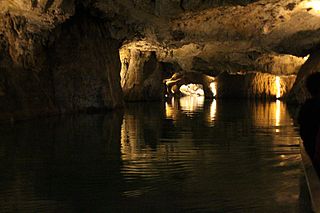 W
WAlabaster Caverns State Park is a 200-acre (0.81 km2) state park approximately 4.5 miles (7.2 km) south of Freedom, Oklahoma, United States near Oklahoma State Highway 50. The park attracted 24,706 visitors in FY 2016, The lowest count of the three parks in its part of Oklahoma. According to the Encyclopedia of Oklahoma History and Culture, the park Previously attracted about 40,000 visitors per year. It is home to the largest natural gypsum cave in the world that is open to the public. The gypsum is mostly in the form of alabaster. There are several types of alabaster found at the site, including pink, white, and the rare black alabaster. This black alabaster can be found in only three veins in the world, one each in Oklahoma, Italy and China. Another form of gypsum can be found in the many selenite crystal formations.
 W
WAtlantida is a karst cave in Ukraine, most famous for its unusual geology, rare formations, and pristine condition. It is located at the bank of the river Zbruch in Kamianets-Podilskyi Raion of the Khmelnytskyi Oblast, close to Zavallya village. The cave is 2525 m long and 18 m deep, with 4440 m² area. Subordinated to the Tourism and Excursions Council of Khmelnytskyi Oblast, the cave is a part of the Podilski Tovtry National Nature Park.
 W
WThe Barbarossa Cave is an anhydrite cave in the Kyffhäuser Hills near Rottleben in the east German state of Thuringia. It is a cave with large caverns, grottos and lakes. The anhydrite has formed gypsum on the surface due to the air moisture in the cave and, as a result, has increased in volume. The resulting layers of gypsum gradually separate from the underlying rock and hang like wallpaper from the walls and ceilings of the caverns.
 W
WCave of the Crystals or Giant Crystal Cave is a cave connected to the Naica Mine at a depth of 300 metres (980 ft), in Naica, Chihuahua, Mexico.
 W
WThe Domtar Mine, formed from the consolidation of Grand Rapids Gypsum Company mines 1 & 2, is an inactive underground gypsum mine in Walker, a suburb of Grand Rapids, Michigan.
 W
WThe Gypsum Cave Mine is a gypsum-anhydrite and uranium mine located in the city of Clark in the Intermontane Plateaus of Nevada, 12 miles east of North Las Vegas, Nevada.
 W
WThe Heimkehle is one of two great gypsum caves in Germany that are accessible as show caves. It lies on the southern edge of the Harz Mountains between Rottleberode and Uftrungen, east of Nordhausen, right on the state border between Thuringia and Saxony-Anhalt. The cave may be visited as part of a 45-minute-long guided tour.
 W
WOptymistychna is a gypsum cave located near the Ukrainian village of Korolivka, Borshchiv Raion, Ternopil Oblast. Approximately 230 km (140 mi) of passageways have been mapped within. As a result, it is the longest cave in Eurasia and the fifth-longest cave in the world, after Mammoth Cave, Sistema Sac Actun, Jewel Cave and Sistema Ox Bel Ha. It is also the longest gypsum cave in the world.
 W
WOrda Cave is a gypsum crystal cave found underneath the western Ural Mountains. The mouth is near the shore of the Kungur River just outside Orda, Perm Krai in Russia. The cave system stretches over 5.1 kilometres (3.2 mi) with around 4.8 kilometres (3.0 mi) over the overall length being under water. This makes it one of the longest underwater caves and the largest underwater gypsum cave in the world. It contains the longest siphon in the former Soviet Union.
 W
WSaint-Léonard underground lake is located at Saint Léonard in the canton of Valais, Switzerland. It is formed where a bed of Triassic gypsum, emplaced within impervious Carboniferous strata, has been dissolved by groundwater. With a length of 300 and a width of 20 m it is the largest underground lake in Europe. It was discovered in 1943 by Jean-Jacques Pittard. Prior to 1946 the water-level was much higher, but an earthquake with a force of 5.6 on the Richter-scale opened additional fissures in the cave on January 25, 1946 made it more readily navigable. Its water is constantly at 11 °C (52 °F). The lake is accessible by the public since 1949. Visits are organized daily from March 15 to November 1, from 9 am to 5 pm. The visit is about half an hour long, and is held in English, French, German and Italian. Ticket-prices are 10 CHF for adults and 5 CHF for children.